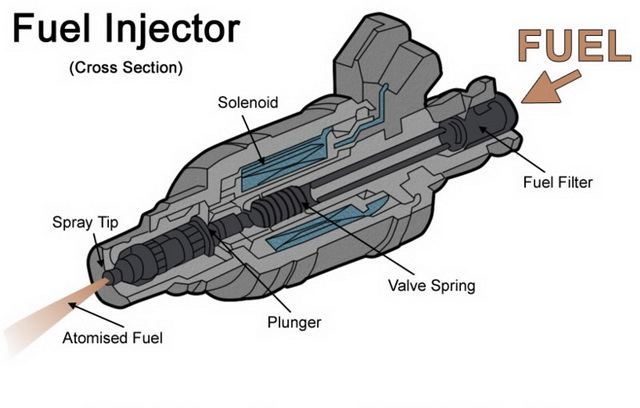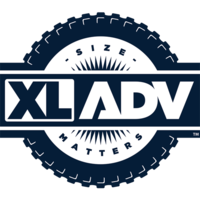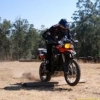
I'll start with the basic components and try to explain how this system operates from there.
Here's an component abbreviation table
MAP = Manifold Absolute Pressure Sensor
The MAP sensor is used to read Barometric pressure at key on. It monitors engine vacuum which it used to determine engine load by comparing it to the TPS reading. This would be how the ECM checks altitude also. It may also sense altitude change at WOT if programed to so.
TPS = Throttle Position Sensor
The TPS sensor tells the computer what position the throttle is in. It's as simple as that.
CTS = Coolant Temperature Sensor
The CTS sensor provides the engine coolant temperature using a voltage reading, transmit it to the ECM.
O2 = Oxygen Sensor
The O2 sensor monitors the oxygen level(air/fuel ratio) in the exhaust so the computer can adjust as need when in closed loop mode once heated by the exhaust. The sensor outputs voltage about how much 02 present in the exhaust. (used by the ECM for monitoring combustion efficiency). They allow the electronic fuel injection to operate in a closed loop system improving emission control and fuel economy dramatically. They help determine, in real time, if the air–fuel ratio of a combustion engine is rich or lean. Since oxygen sensors are located in the exhaust stream, they do not directly measure the air or the fuel entering the engine. Instead they measure the amount of oxygen in the exhaust after combustion. The information supplied from oxygen sensors is coupled with information from other sources, it can be used to indirectly determine the air-fuel ratio. Closed loop feedback-controlled fuel injection varies the fuel injector output according to real-time sensor data rather than operating with the predetermined (open-loop) fuel map. The O2 sensor used in this system is normally a narrow band type O2 sensor
IAC = Idle Air Control valve/stepper motor
The IAC is a air bypass valve that is used to control the engine speed at idle. The throttle body allows a predetermined amount of air past the throttle blade and the IAC controls the extra air flow needed to reach the correct idle speed and prevent stalling. The IAC is a stepper motor that allows extra air into the engine to control the idle speed. The throttle closes slightly further which decrease emissions on deceleration. When the RPM drops low enough the IAC takes over to control the idle speed. There is a minimum air flow specification that the throttle stop screw is adjustment determines. It is preset by the factory and may be painted so tampering can be determined.
CPS = Camshaft Position Sensor
The CPS identifies the camshaft position, can be used to sense when the engine fires.
CKP = Crankshaft Position Sensor
The CKP sensor identifies the crankshaft position, RPM and can be used to sense when the engine fires (or even misfires).
IAT sensor = Intake Air Temperature sensor
The IAT monitors the air temperature going into the engine. Cold air is denser and has more oxygen in it. It is used in combination with the other sensor values to help determine the correct air/fuel ratio.
ECM/PCM = Engine/Powertrain Control Module
EEPROM = Electrically Erasable Programmable Read Only Memory
The part of the controller that stores it's memory.
MIL = Malfunction Indicator Lamp (aka check engine light)
DLC = Data Link Connector
The connection used to extract codes or sensor readings and perform reprograming.
OBD = On Board Diagnostics.
The tests and parameters the ECM uses to establish DTC's
DTC = Diagnostic Trouble Code
BAS = Bank angle sensor
The Bank angle sensor monitors the bikes angles and shuts it off when crashed. It is designed for safety where in if the bike is laid down or in a roll over, the fuel pump is shut down so as not to potentially cause a fire.
VSS = Vehicle Speed sensor
Monitors vehicle speed.
Open loop is when the engine is monitoring the sensors and running on base programing.
Closed loop is when the engine is monitoring the sensors and adjusting as needed to maintain the "desired" air/fuel ratio to achieve complete combustion.
The controllers and sensors normally use a 5 volt circuit just like automotive sensors do. The principles of operation are also the same.
A high impedance digital volt/ohm meter should only be used when testing is done.
Note: Do not use a analog meter or low impedance meter for testing. System damage may result...
System operation
There are multiple open and multiple closed loop cells. In open loop the ECM monitors the TPS, MAP, CKS, IAT and the CTS sensors mainly and the engine runs on the just the compensation tables programed in each memory cell. It uses these values to determine what base programing cells in the computer to use for the current conditions present.
In closed loop operation the ECM also monitors the O2 sensor, using it to provide the information the computer needs to achieve the desired air fuel/ratio results to meet the ECM goals for the compensation tables in each memory cell. It does this by adjusting by the short term adaptive memory and long term adaptive memory as needed to the reach these programed operational goals. Adaptive memory is the computers ability to adapt to and remember what is needed to achieve the desired air/fuel ratio in closed loop mode. It has the ability to add or subtract fuel as needed. The ECM monitors the short term adaptive memory adjustments and converts them into long term adaptive memory adjustments so it will retain its ability to meet the desired operational goals that are programed quickly by storing adjustments for your next ride. Short term memory is quick and volatile, constantly changing as needed. It isn't stored after engine shut down
During mid to full throttle operation the ECM reverts back to open loop mode since the O2 sensor is unable to read the air/fuel ratios needed at this time. Some systems also operate in open loop at idle.
.
The live adjustments done by the adaptive memory are kind of like having a tuner along for the ride to make adjustments as needed for maximum fuel economy.
It is quite difficult to program a plain set of compensation tables to run correctly in all conditions. Adaptive memory can subtract or add fuel to meet the operation goals exactly. Without adaptive memory the compensation tables are more of a close enough type of system which wouldn't be viable to use to achieve as accurate state of tune, low emissions and maximum fuel economy.
Hopefully this information will come in handy when modifications are performed to the engine for performance and tuning reasons.
Reprograming is necessary for many modifications or to adjust the power delivery by changing the open loop memory tables as needed.









Recommended Comments
There are no comments to display.
Join the conversation
You can post now and register later. If you have an account, sign in now to post with your account.